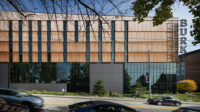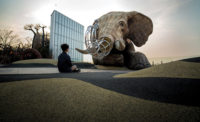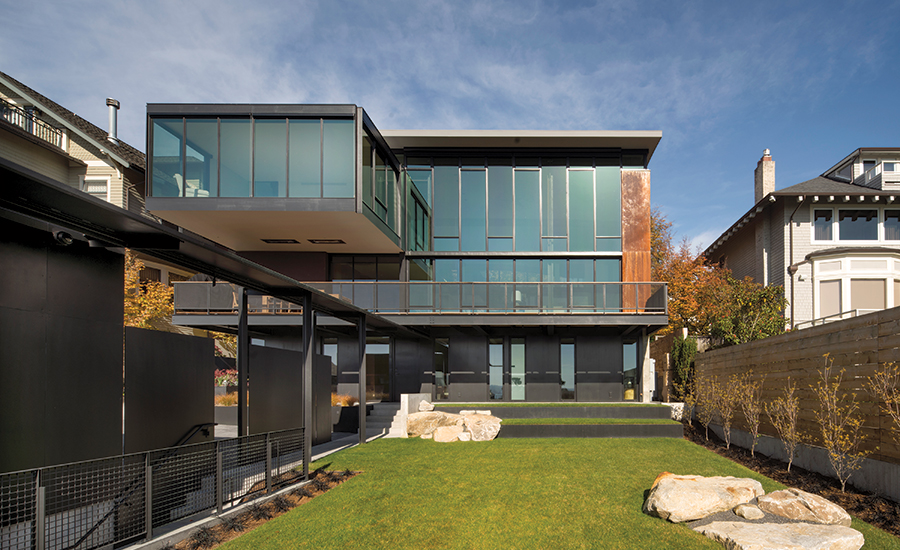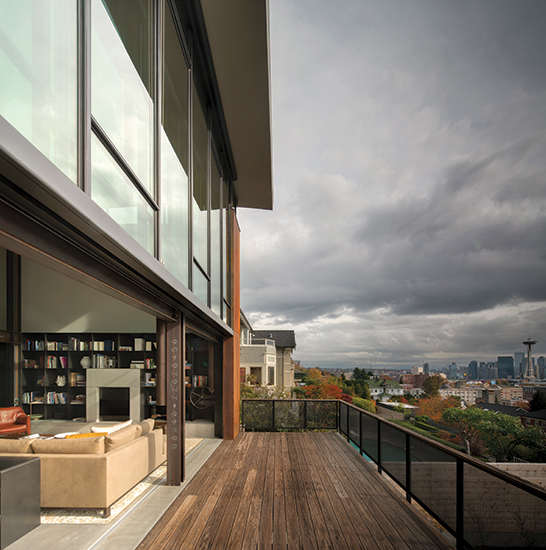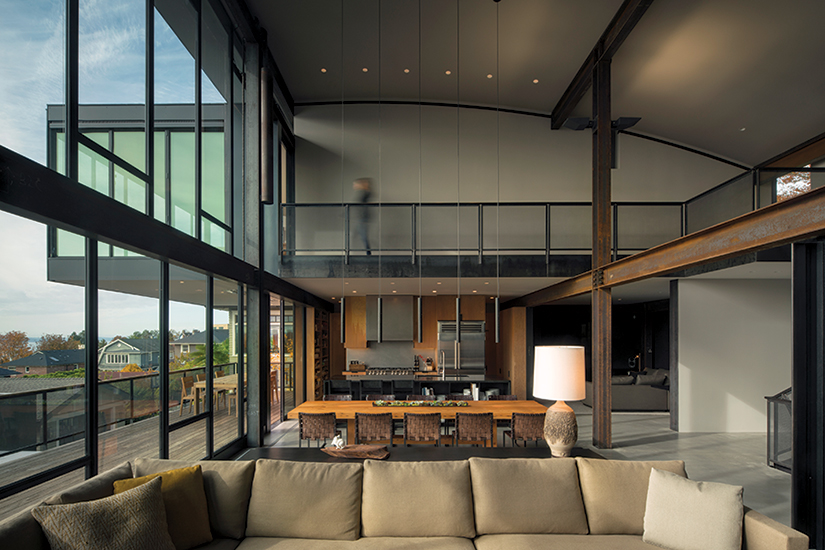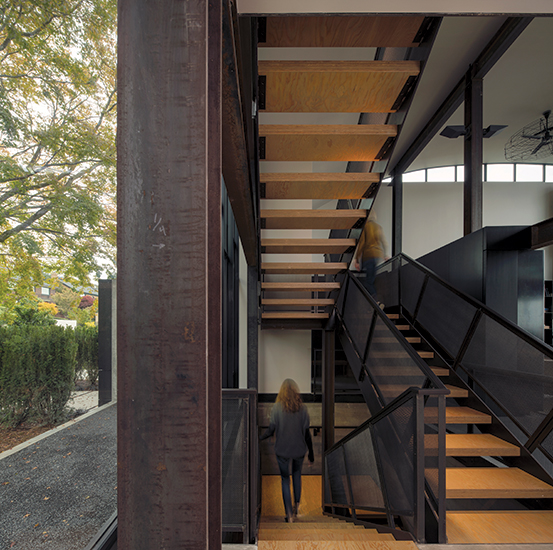Meg Home by Olson Kundig
Seattle

On the narrow 1⁄5-acre site with rocky additions, Olson Kundig took advantage of views of Elliott Bay and downtown Seattle. The bedrooms are at ground level, with a double-height living and dining level above.
Photo © Nic Lehoux

Through retractable windows there, the deck and the panorama are accessible. A covered walkway leads to the garage and workshop.
Photo © Nic Lehoux

From the street, the house appears to be a two-story bungalow hidden behind Japanese maples and a yew hedge. Inside, however, it opens up dramatically to the view.
Photo © Nic Lehoux

The living area adjoins a dining area, while the kitchen is inserted beneath the bedroom.
Photo © Nic Lehoux

The living area adjoins a dining area, while the kitchen is inserted beneath the bedroom.
Photo © Nic Lehoux

The master bedroom cantilevers over the deck to take in the view.
Photo © Nic Lehoux

Open-riser stairs at the entrance connect the three levels without blocking light, or the sense of interior space.
Photo © Nic Lehoux

Image courtesy Olson Kundig Architects

Image courtesy Olson Kundig Architects

Image courtesy Olson Kundig Architects

Image courtesy Olson Kundig Architects











Architects & Firms
Gianna Puerini and Brian Valentine interviewed five architects to design their house in Seattle’s Queen Anne area—a picturesque enclave on a hill high above downtown— before choosing Tom Kundig, who lives in the same neighborhood. “It just felt right,” says Puerini, a vice president of Amazon Go. She and Valentine, a CEO of a startup that converts food waste to fertilizer, told Kundig, “We wanted what he did, but we wanted it to be our home. He got it.”
The architect has some experience with houses, having completed more than 75 of them in a career that spans three decades. And he continues to design them even though his firm, Olson Kundig, now has a staff of 150 and takes on larger commissions around the globe. “I’ve always enjoyed smaller, more intimate projects,” he says. “They inform the larger ones.”
The most celebrated of Kundig’s residential works, such as a studio called the Brain (2001), the Stilt Cabin, and Montecito Residence (RECORD, May 2009), tend to be freestanding pavilions in spectacular landscapes. By contrast, this one is a discreet intervention on a constrained lot in a century-old cityscape. Asked how these site conditions affected his design process, Kundig replies, “My focus is always on context, whether natural or urban. From that, you derive the necessary information to help shape the building appropriately.” This approach led him to a scheme that takes full advantage of a sloped site offering both frontage on a handsome street and a 180-degree view of the Seattle skyline and Puget Sound.
With two stories visible in front but three in back, where the grade is lower, the 6,050-square-foot dwelling has two scales: smaller and subtler where it addresses the residential street, bigger and bolder where it takes in the panoramic prospect. To reconcile this duality, explains Kundig, “We tried to balance transparency with a sheltering sense of refuge. It’s the yin and the yang.”
The architect thoughtfully aligned the house with its neighbors by setting it farther back from the sidewalk than zoning regulations required. He also placed the entry sequence off to one side. These moves yielded a large, private garden shaded by two mature Japanese maples and shielded from the street by a yew hedge. Planning is functional if less artful at the back of the site, where a covered walkway, connecting to a green-roofed garage and studio, divides an auto court from a lawn.
Massing consists of one primary volume rising from a basement that negotiates the grade change, with a smaller secondary volume projecting out from the upper level. Hovering above, a curved roof dips down asymmetrically to protect the recessed front door at the corner. Exterior walls are mostly steel and concrete at the sides, providing privacy, and largely glass at the front and back, opening sight lines between the sheltered outdoor room on the street side to the north and the sweeping city and water view to the south.
Inside, three parallel frames of steel columns and beams delineate two spatial layers, arranged in an open plan, while a ceiling that conforms to the shape of the vaulted roof establishes a volumetric hierarchy in section. At the front, a vestibule opens onto a stair hall and a media alcove, both facing the garden. At the back, overlooking the vast vista, are a kitchen and a show-stopping double-height living and dining room, where a manually operated system of pulleys and counterweights lifts an expansive window wall to provide access to a deck spanning the building’s entire 50-foot width. On the lower level, nestled into the hillside, are three guest rooms. On the upper level is a master suite whose cantilevered bedroom, wrapped in glass, forms a vertiginous perch from which to contemplate the sea and city beyond.
Materials, finishes, and details adhere to the elemental yet elegant architectural vernacular Kundig has developed over many years. Steel, both weathering and blackened, is ubiquitous. It appears not only in the articulated structure but also in cladding, sash, cabinetry, fittings, and in the trademark wheel that raises and lowers the retractable glass wall. Rust, welds, and shop markings on exposed columns and beams remain intentionally visible. Concrete’s strong supporting role emerges in boardformed walls and lightly polished floors. Millwork, stair treads, and upper-level flooring are buffed fir plywood. Despite the contextually constricted character of this project, Kundig still evokes and even fulfills Le Corbusier’s aspiration “to establish a play between crudity and finesse . . . to make beauty by contrast.”
The clients’ aesthetic preferences invert gender stereotypes. Puerini loves modernism. “I’m all about straight lines and right angles,” she says with a laugh. But Valentine wanted a softer touch. “I asked for the curved roof,” he explains. “It gives all the hard edges below a more human, organic quality.” Their shared passion for Seattle’s football team, the Seahawks, inspired the roof’s parabolic profile, mimicking the arc of a pass thrown by star quarterback Russell Wilson. It’s an apt metaphor for muscular architecture of restrained power and grace.
CreditsArchitect: Olson Kundig —Tom Kundig, design principal; Angus MacGregor, project manager; Justin Helmbrecht, project architect (schematic design and
Engineer(s): MCE (structural); Coughlin Porter Lundeen (civil)
Consultant(s): DM Ohashi Landscape Services (landscape); Veronika Batho-Demelius (lighting)
General contractor: Schuchart Dow
|
SpecificationsSteel frame Brombal and Glacier
Glass Cardinal Glass Industries
Levers and pulls The Tom Kundig Collection by 12th Avenue Iron
Paints and stains Benjamin Moore; Farrow & Ball
Wall coverings Filtzfelt
Solid surfacing Ann Sacks; Pental Surfaces |


